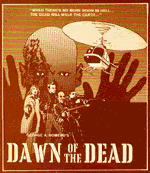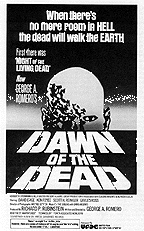
DAWN OF THE DEAD DISTRIBUTION

By winter 1978, Warner Brothers, American International Pictures (who'd turned down NOTLD in 1968) and United Film Distribution all were interested in distributing Dawn. Though by today’s standards and by its outdated effects, the M.P.A.A. would have rated this picture an hard R (Restricted), they were prepared to rate it an X (No one under 17 admitted) unless the gore was cut out. "We felt that cutting the picture to fit the rating system would destroy it," Rubinstein explained to the Associated Press. "The flaw in the rating system is that X carries the connotation of sex. There is no sex in Dawn of the Dead. Not even a kiss."
Very few studios were looking to release an X rated film with so much of the audience restricted. Since it was perfectly legal to release an unrated film, Laurel decided to do that with their own warning: "There is no explicit sex in this picture. However, there are scenes of violence that may be considered shocking. No one under 17 will be admitted." Still, neither Warner Bros. or AIP were interested in such a risky rating, but still were interested if cuts were made to ensure an R rating. Romero stuck to his guns and decided not to make these edits which would take away part of the film’s identity, part of its visual impact and theme. Finally one of the three potential distributors gave in.

"The picture is being released not by a major but by United Film Distribution Company, a subsidiary of United Artists Theatres," Romero told the press of the same outfit who handled Martin. "The film has no rating but it carries the admonition that no one under 17 will be admitted without a guardian. Being unrated has hurt us. In places like Chicago and Maryland we are unable to advertise on TV until after 11 at night." Romero knew time had come for a new rating, an "A", for films that were not sexual or pornographic, but aimed at adults for graphic violence and language content. In 1990, NC-17 was instituted, which essentially was the equivalent of Romero’s proposed "A" rating. Since Dawn, other independent horror filmmakers have used the exact warning on their own features like William Lustig's Maniac (1980) for instance and Lucio Fulci's Zombie.
In Sept. 1978 Titanus Films of Rome, Italy released the first incarnation of Dawn to its native country as Zombi: L’alba dei Morti Viventi. In March 1979, French distributor Rene Chateau followed with Zombie: Le Crespescule des Morts Vivants, Spain with Zombi: El Regreso de los Muertos Vivientes, The Netherlands with Zombie: In De Greep van de Zombies, Germany’s Constantin Films with Zombie and Denmark with Zombie: Raedslernes Morgan.
Dawn of the Dead premiered in New York April 13, 1979 to the Village Voice’s Tom Allen’s prediction that "it's going to be the biggest cult blockbuster of all time." A week later, the film had a Northeastern run and 400 prints were readied for pre-summer release. The Mideast and Southern openings took place on July 13, 1979. An R-rated edit was reissued in May 1981 with Romero’s Knightriders and later coupled with Creepshow in October 1982.
"Four stars-…brilliantly crafted, funny, droll, disgusting, …a savagely satanic vision of America…how can I defend this depraved trash? I do not defend it. I praise it. Nobody said art had to be tasteful."-Roger Ebert, Chicago Sun-Times
"Three and a half stars-apocalyptic horror masterpiece; Satiric, metaphorically rich adventure jerks viewers' emotions around with stunning ease, as zombies are, by turns, horrifying, heroic, made clownish, and even forgotten. " – Leonard Maltin
"Dawn will curl your
toes.....Romero is an audacious, stunningly talented film maker" (Bruce
Williamson, Playboy). "One of the most intriguing, terrifying horror films
I've seen in years. I recommend it unreservedly" (Daily Express). "As
scary a movie as you could hope to see in a month of nightmares." (Daily
Star).
"Without a doubt the most horrific, brutal, nightmarish descent into hell
(literally) ever put on screen, and its power can be gauged by the peals of
maniacal laughter bursting forth from many of us who survived the movie’s
first few moments. The film gave me nightmares so severe that I awoke afraid to
return to sleep, its frames burned forever on my consciousness in an indelible
way." - C.W. Smith, Dallas Times-Herald
"Its genius is its setting: Dawn takes the fundamental premise of its predecessor and shifts locale to a suburban shopping mall. The zombies come to represent our consumer culture gone awry, a blackly humorous entrée to the Reagan-Bush era and the literal eating away of America." – Douglas Winter
"stylistically cool, sledgehammer editing without optical tricks or slow motion.." - Tom Allen
Variety particularly loathed the movie: "For the light of head and strong of stomach, Dawn pummels the viewer with a series of grisly events that make special effects man Savini the real star of the film. That’s fortunate since the actors are as woodenly uninteresting as the characters they play. Romero’s script is banal when not incoherent. Those who haven’t seen Night may have some difficulty deciphering exactly what’s going on at the outset of Dawn. There’s virtually no plot or character development. Romero introduces the mayhem at key points when storyline and dialogue threaten tedium. There’s a predictable denouement with two of the four characters escaping unscathed." Others on the negative side: "I have a pet peeve about flesh-eating zombies. I was able to sit through only the first 15 minutes of Dawn." (Janet Maslin, New York Times). "A wretched excess, despite Romero’s undeniably resourceful filmmaking talent." (The Washington Post).
Some critics didn’t know how to place it. "Either the most sickening film of all time or one of the funniest ever" Bob Freund of the Fort Lauderdale News wrote, who was one of the critics who rated it just one star. "Dawn misses the point of the classic horror film – don’t show too much of your monster. Alien is a prime example of how to instill terror. Dawn is silly to the extreme. The audience with which I viewed this movie with was literally rolling in the aisles with laughter at each new onslaught of the mummified parade. The entire concept of Dawn produces guffaws practically from the start. These [zombie] extras made up with grey paint, become instead of the terrifying creatures they are supposed to be represent, a bunch of funny-looking Halloween masquers out on a drunken toot. The ending is fairly predictable but two hours of this nonsense might find the patron not caring about the outcome at all." Similarly, Bob Cosford of Miami Herald called it "a stab at art that fails…drowns in its own blood…there is little you can do by the end but shake your head in dismay."
TECHNICAL SPECS
No MPAA rating: Graphic violence, gore, language, brief nudity.
U.S. Theatrical Prints run 127 mins.
UK Theatrical Prints run 120 mins. as Zombies (Target International)
European Prints run 114-116 mins. as Zombi: D'alba dei Morti Viventi (Titanus);
Zombi: Le Crespescule des Morts Vivants (Rene Chateau) ; Zombi:
Regreso de los Muertos
Japanese Prints run 120 mins. as Zombie: Dawn of the Dead (Herald
Pictures)